Recognizing the Diverse Profession Paths Available for Aspiring Architect
As an aspiring Architect, you have a globe of occupation courses waiting for you. Whether you're attracted to conventional design or the subtleties of lasting design, there's a particular niche that lines up with your interests.
Standard Style: Creating Structures and structures
Conventional architecture focuses on developing structures and structures that blend performance with visual appeal. Your designs can reflect social heritage, showcasing neighborhood customs while meeting contemporary needs.
You'll establish abilities in composing, model-making, and website evaluation, permitting you to imagine and interact your ideas properly. Involving with clients, you'll need to recognize their vision and translate it into possible styles.
In addition, constructing codes and sustainability techniques are necessary in your work, guaranteeing your structures are secure and environmentally pleasant. As you grow in your profession, you'll discover possibilities in property, commercial, or perhaps remediation projects, each offering unique challenges. Welcoming traditional design leads the way for a satisfying career that pays homage to the past while shaping the future.
Urban Preparation: Shaping Communities and Public Spaces
As an aspiring Architect, you can play a crucial role as a city coordinator, transforming just how communities work and connect. By employing area interaction techniques, you'll assure that locals have a voice fit their setting. And also, integrating lasting style principles will certainly aid develop areas that not just fulfill today's requirements yet also safeguard the future.
Duty of Urban Planners
While numerous could believe of architects as the sole enthusiasts behind buildings, city organizers play an essential function in shaping the more comprehensive landscape of communities and public areas. By collaborating with numerous stakeholders, you'll assist create parks, transport systems, and residential areas that promote social communication and availability. Your experience in spatial design and area characteristics enables you to envision future growth while preserving cultural heritage.
Community Interaction Techniques
Effective neighborhood engagement approaches are crucial for metropolitan coordinators to ensure that the voices of locals are heard and valued in the preparation process. To cultivate purposeful discussion, you need to prioritize open discussion forums and workshops where area members can share their concepts and problems. Use studies and social networks to reach a broader target market, making certain diverse perspectives are included. Working together with neighborhood companies can enhance count on and help with much deeper links. It is very important to provide clear details about proposed projects and decision-making procedures, permitting residents to really feel informed and empowered. By actively paying attention and incorporating responses, you'll develop areas that reflect the community's requirements, ultimately resulting in even more lasting and effective city atmospheres. Welcome transparency and continual dialogue for long-term effect.
Sustainable Layout Concepts
When making city rooms, integrating lasting style principles is important for producing atmospheres that grow both ecologically and socially. You should start by concentrating on power effectiveness, utilizing products that decrease waste and promote recycling. Think about incorporating eco-friendly spaces, like parks and yards, to boost biodiversity and improve air high quality. Promoting walkability and public transportation can lessen dependence on vehicles, promoting a healthier community.
Creating with water conservation in mind is also vital-- consider rain yards and permeable surfaces to manage stormwater. Involving area members throughout the preparation process warranties that the spaces you create fulfill their requirements and urge social interaction. By accepting these principles, you'll add to lively, sustainable metropolitan landscapes that benefit every person.

Landscape Design: Producing Sustainable Exterior Settings
As you explore landscape design, you'll find crucial layout principles that produce functional and gorgeous outside areas. Sustainable practices play a vital role in ensuring these settings grow while lessening environmental impact. And also, you'll discover a range of profession possibilities that permit you to make an actual difference in how people communicate with nature.
Layout Principles in Landscape
Comprehending layout concepts in landscape design is essential for developing sustainable outdoor environments that harmonize with nature. You'll need to contemplate components like range, balance, and percentage to ensure your layouts really feel natural and welcoming. Integrating indigenous plants not just enhances biodiversity but likewise lowers water usage, making your landscape resilient. Assume regarding the circulation of area and how individuals communicate with it; pathways and seating areas must welcome exploration and leisure. Additionally, take note of seasonal adjustments, developing with materials that complement the surroundings year-round (Architect). By prioritizing sustainability and looks, you can produce exterior spaces that enhance the area and promote wellness. Welcoming these concepts will set a strong structure for your job in landscape architecture.
Lasting Practices Introduction
Sustainable techniques in landscape design not just focus on aesthetic appeals yet also prioritize environmental health and resource conservation. By integrating native plants, you enhance biodiversity and decrease the need for chemical fertilizers and chemicals. Implementing efficient irrigation systems aids preserve water and lessens runoff, safeguarding close-by environments. You can make spaces that promote soil health and wellness, such as practicing and using natural materials permaculture principles. Furthermore, integrating environment-friendly framework, like rain yards and porous sidewalks, aids in stormwater monitoring and reduces city heat. When you produce outdoor atmospheres with sustainability in mind, you contribute to a much healthier world and provide spaces that foster neighborhood link. Eventually, these techniques ensure your layouts profit both people and the environment for many years ahead.
Job Opportunities Exploration
With a strong structure in sustainable methods, landscape design supplies a variety of job paths that enable you to make a purposeful effect on the setting. You could function as a landscape designer, developing visually pleasing and functional exterior areas, or focus on eco-friendly repair, aiding to revitalize broken ecosystems. Urban coordinators often work together with landscape designers to produce environment-friendly spaces in metropolitan setups, enhancing city livability. If you're enthusiastic about education and learning, think about coming to be a landscape design instructor, inspiring future generations. Additionally, you might deal with nonprofits focused on ecological sustainability or take part in research study to introduce new practices. Each path not only shapes stunning atmospheres yet additionally fosters a much healthier world for future generations.
Lasting Design: Concentrating on Eco-Friendly Practices
As you discover your profession in design, welcoming environment-friendly techniques can establish you apart in a competitive area. Lasting layout concentrates on developing structures that decrease ecological effect while enhancing passenger health. By integrating renewable materials, energy-efficient systems, and lasting structure strategies, you'll add to a greener future.
Begin by getting expertise of environment-friendly accreditations like LEED or BREEAM, which can boost your credentials. Take into consideration just click for info how all-natural light, ventilation, and thermal efficiency can optimize design. Collaborate with designers and ecological experts to introduce services that reduce waste and conserve resources.
Don't fail to remember the importance of neighborhood participation-- engaging local stakeholders can motivate styles that harmonize with the setting. As customers progressively prioritize sustainability, your expertise in environment-friendly practices will not only draw in tasks but also satisfy your passion for responsible style. Welcome this vital aspect of the profession, and watch your occupation prosper.
Historic Preservation: Safeguarding and Bring Back Social Heritage
While you begin on your building trip, think about the vital function of historic conservation in maintaining our cultural heritage. This area concentrates on the security and restoration of substantial buildings, websites, and frameworks that tell the stories of our past. By taking part in historic conservation, you'll assist guard the building tradition that shapes neighborhood identity.
As a historical conservation Architect, you'll assess historical importance and examine the problem of structures. You'll function very closely with preservationists and chroniclers to assure genuine reconstruction strategies are employed. This occupation course permits you to blend imagination with research study, enabling you to design remedies that respect initial products and workmanship.
Your job not just adds to sustainability by reusing existing buildings yet likewise cultivates a feeling of pride within neighborhoods. Welcoming this path will aid you become a guardian of history, preserving the stories and visual appeals that improve our lives.
Inside Architecture: Enhancing Indoor Spaces
Historic conservation and indoor architecture both share a commitment to boosting the developed setting, yet they concentrate on various facets. While historic preservation emphasizes preserving a framework's social and historical worth, interior design nos in on optimizing interior rooms for functionality and aesthetics.
As an ambitious Architect, you'll locate that interior style allows you to blend creative thinking with technological abilities. You'll develop spaces that not just look great however also promote comfort and efficiency. This area includes comprehending exactly how light, shade, and products communicate within an area, impacting mood and use.
You'll function on various projects, from household homes to Website industrial workplaces, guaranteeing that each environment satisfies the needs of its residents. By prioritizing customer experience, you can change insides into inspiring and practical spaces, making a substantial influence on how people connect with their environments. Accept the possibility to boost interior environments and shape the way people live and function.
Industrial Design: Merging Functionality With Looks
Industrial style plays a necessary function in producing products that perfectly mix appearances with capability, guaranteeing that what you utilize day-to-day is not only aesthetically appealing however additionally useful. As a hopeful Architect, you might immerse on your own in this area, focusing on creating whatever from furnishings to customer electronic devices. Your work involves comprehending individual requirements, materials, and manufacturing processes, allowing you to produce cutting-edge remedies that boost daily experiences.
In commercial layout, you'll frequently work together with manufacturers, designers, and marketers, ensuring that your styles are not only lovely however likewise practical. This occupation course provides a dynamic atmosphere where creativity satisfies usefulness, making it a fulfilling option for engineers interested in forming the products of tomorrow.
Often Asked Questions
What Educational Accreditations Do I Required to Become an Architect?
To become an engineer, you'll require a professional degree in architecture, normally a Bachelor's or Master's. Furthermore, you'll need to finish a teaching fellowship and pass the Architect Registration Examination to practice lawfully.
Exist Qualification Needs for Various Building Profession Paths?
Yes, there're qualification demands for various architectural courses. Architect. You'll require to pass exams, total teaching fellowships, and in some cases go after specialized training, depending upon your selected emphasis, like landscape architecture, metropolitan style, or historic preservation
What Software Application Skills Are Necessary for Architects Today?

How Can I Gain Practical Experience While Studying Style?
You can get sensible experience by interning at architectural companies, joining design competitors, volunteering for neighborhood tasks, or collaborating with schoolmates on real-world projects. These opportunities enhance your abilities and build important links find this in the market.
What Job Opportunities Exist Outdoors Conventional Architecture Firms?
You can check out various job possibilities outside conventional architecture companies, like metropolitan preparation, interior decoration, landscape architecture, construction monitoring, actual estate growth, or perhaps functions in sustainability consulting. Each offers one-of-a-kind difficulties and rewards.
Whether you're attracted to typical architecture or the nuances of sustainable design, there's a specific niche that aligns with your interests.When making urban rooms, integrating sustainable style principles is critical for developing atmospheres that thrive both environmentally and socially.As you explore landscape style, you'll uncover necessary layout principles that produce gorgeous and practical exterior spaces.Comprehending style principles in landscape design is important for creating lasting outside settings that harmonize with nature.In industrial style, you'll commonly work together with producers, marketing experts, and engineers, ensuring that your styles are not only lovely yet also feasible.